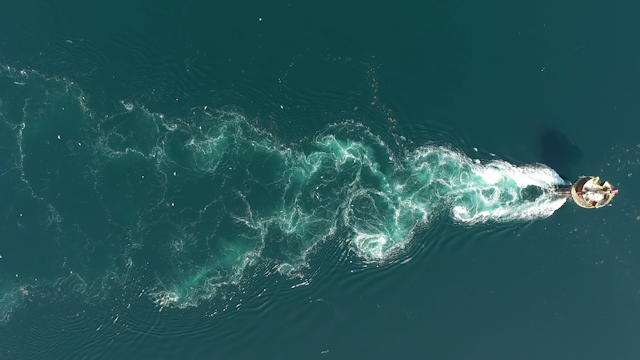We are living in an era of intense marine urbanisation. More and more artificial structures are being built in the seas and oceans and, while many aim to combat climate change through exploiting wind or tidal energy, there are concerns over what this means for marine ecosystems. Offshore wind farms can present barriers to bird migration, while for seals, tidal turbines present an increased level of underwater noise or collision risk.
On the other hand, there are some indications that introducing man-made structures leads to new opportunities for some animals. Marine life can settle on old oil rigs, turning them into artificial reefs. Fish can seek refuge in their wake, while seals use structures as foraging sites. All of these environmental interactions need to be considered.
That’s why we decided to investigate how turbulent wakes generated downstream from man-made structures can act as a form of “conveyor belt” for surface foraging seabirds, serving up a continuous stream of fish. Our results are published in the journal Communications Biology.
Let’s rewind. Coastal waters are already very dynamic and complex marine habitats, characterised by headlands, islands or submerged rocks. Where strong tides rush past these features it can lead to turbulent swirls or eddies, including wakes left behind small islands, pier pillars or floating buoys.
Placing large offshore structures into such energetic environments can therefore change local flows, ranging from large sediment wakes behind offshore windfarms, to the emergence of distinct eddy-dominated wakes spanning tens to hundreds of meters behind tidal turbines.

Where you see such turbulence, the chances are you see seabirds too. Seabirds scan the waters for conspicuous turbulent patches as there could indeed be something in the water. In fact, these turbulent flows can break up shoals of small fish or even displace individual fish. This can make small prey items available to surface-foraging seabirds such as gulls and terns.
Often nicknamed “sea swallows”, terns are rather slender and elegant seabirds and will only skim the surface or perform very shallow plunges to access their fishy prey. They rely on strong physical processes, such as turbulence or upwelling, to bring prey towards the surface.

To understand how terns associate with both natural and man-made wake structures, we set up a study in a highly dynamic tidal channel, linking Strangford Lough in Northern Ireland with the Irish Sea. This is where the UK’s first grid-connected tidal turbine energy structure, SeaGen, was installed in 2008. At the time of our study in the summer of 2018, SeaGen was being decommissioned and its turbine blades had been removed. But the remaining structure still generated a large, turbulent downstream wake, known as a von Kármán vortex street.
We focused our observations around SeaGen’s wake as well as two nearby natural dynamic sites, an island wake and a whirlpool, with the latter characterised by powerful eddies and localised up-wellings. Over the next several weeks, we then sat on the shore and counted the numbers of seabirds we saw foraging over each of the three wake features across different times of day and tidal states.
We found that, on average, there were three times more terns foraging over the flood wake left by SeaGen than over the nearby natural wake sites. This suggests that the former tidal power plant acted as the most reliable conveyor belt for their prey.

What makes the wake a conveyor belt? Imagine tidal flows reaching five meters a second (that is double the top speed of the Olympic swimmer Michael Phelps) rushing past SeaGen. Any small fish caught in these currents would no longer be able to swim against the tide.

To observe this we mapped out the turbulent flows of the wake from below using sound waves, and then used drones to track individual tern flight trajectories from above. Acoustic visualisations showed that SeaGen’s eddy-dominated wake mixes material across the entire water column, lifting potential small prey items towards the surface. Using drones, we could record the highly localised foraging movements of terns directly over the turbulent wake, with the incoming tide constantly replenishing the conveyor belt.
The remaining SeaGen tower is set to be removed this month. It may be replaced by a new generation of tidal devices currently being tested in the lough. But in the meantime, these birds will have to stick to natural foraging sites.

